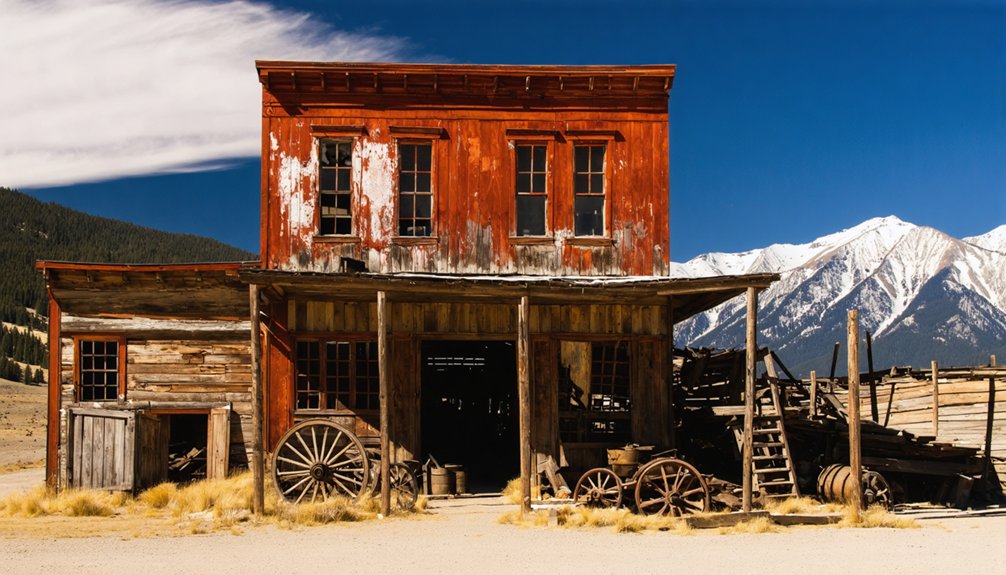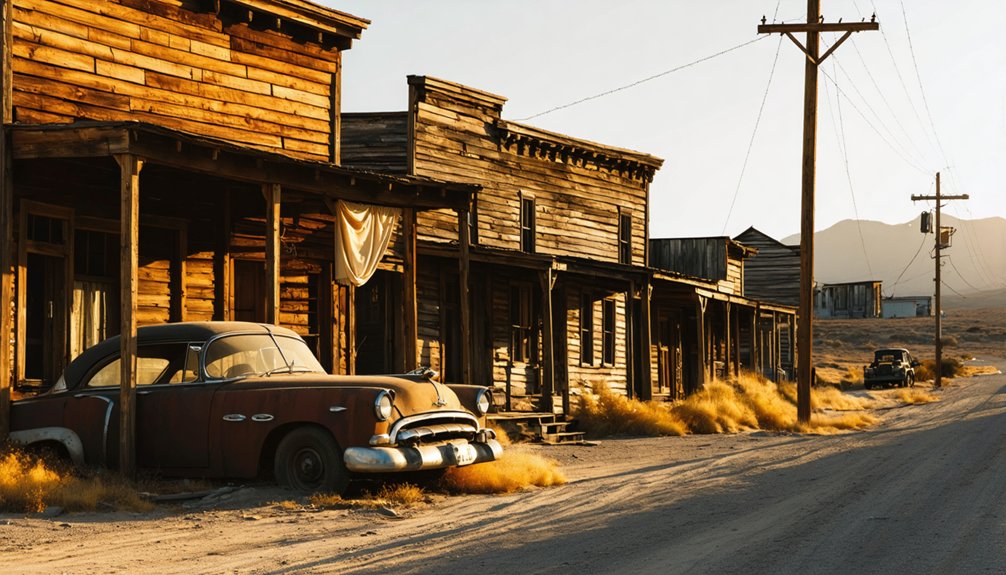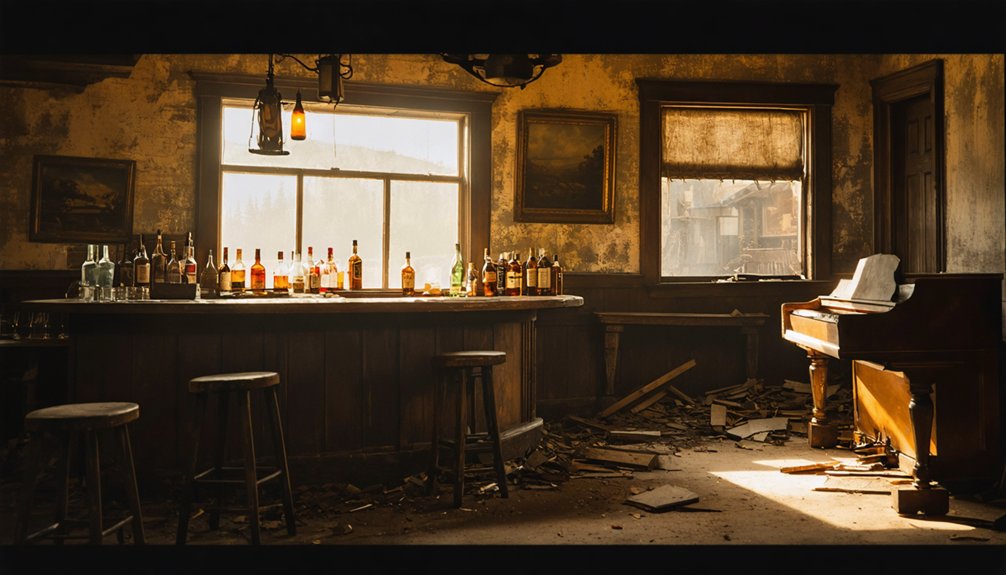You’ll find America’s most fascinating ghost towns scattered throughout the Sierra Nevada, where California’s Gold Rush left an indelible mark. From Bodie’s 170 preserved structures frozen in “arrested decay” to Malakoff Diggins’ massive hydraulic mining pit, each site tells a unique story of boom and bust. Don’t miss Virginia City’s 300 original buildings, Gold Point’s authentic saloons, or Cerro Gordo’s silver mining legacy. These remote mountain settlements hold countless untold tales of the American West.
Key Takeaways
- Bodie stands as California’s best-preserved ghost town with 170 original structures maintained in “arrested decay” from its 1859 gold rush origins.
- Virginia City features over 300 original buildings and attracts millions of visitors annually as a living museum of mining history.
- Cerro Gordo’s silver mining legacy includes vintage buildings and mine ruins across 336 acres, despite recent fire damage.
- Aurora, once Nevada’s second-largest city, produced $27 million in gold but now retains only its cemetery and mill foundations.
- Malakoff Diggins showcases America’s largest hydraulic mining operation with its massive pit and preserved buildings for gold panning experiences.
The Mystique of Bodie: California’s Best-Preserved Mining Town
In the rugged foothills of California’s Eastern Sierra, one of America’s most compelling ghost towns stands frozen in time.
You’ll find Bodie legends etched into every weathered building and dusty street, where gold’s discovery in 1859 sparked a classic Wild West saga. Named after prospector William S. Bodey, who perished in a bitter blizzard, the town’s misspelled name became synonymous with both prosperity and vice.
By 1879, you could’ve joined 10,000 residents amid 2,000 structures, including 65 saloons, countless brothels, and opium dens. A thriving China Town district flourished as hundreds of Chinese immigrants established successful businesses in logging and laundry services. Ghost town lore tells of a young girl’s prayer – “Goodbye God, we’re going to Bodie” – capturing its notorious reputation. The town’s lawless reputation was earned through daily street fights and killings that plagued its dusty streets.
Today, preserved in “arrested decay,” Bodie’s 170 remaining structures offer you an authentic glimpse into the untamed American frontier.
Malakoff Diggins: Giant Gold Diggers of the Sierra
While prospectors crowded the bustling camps near Nevada City, a group of determined miners ventured north in 1851, discovering rich gold deposits that would become America’s largest hydraulic mining operation.
At Malakoff Diggins, you’ll witness the raw power of industrial-scale mining that literally moved mountains in pursuit of gold. The North Bloomfield Gravel Mining Company transformed this landscape using massive water cannons to blast away entire hillsides, leaving behind a colossal pit that’s still visible today. The operation released 1 billion tons of mining debris into nearby rivers and valleys. They constructed miles of canals to transport water from the Sierra Nevada Mountains for their mining operations.
- French miners named it “Malakoff” after their victory in the Crimean War
- The operation employed over 1,100 workers, including 800 Chinese laborers
- Their hydraulic mining carved out a pit 6,900 feet long and 600 feet deep
- Today’s ghost town preserves original buildings and offers gold panning opportunities
Gold Point: Where Nevada’s Mining Spirit Lives On
Despite its humble beginnings as a limestone mining camp in the 1880s, Gold Point emerged as one of Nevada’s most fascinating boom-and-bust stories.
You’ll find that the town’s transformation accelerated after the Great Western Mine Company’s silver discovery in 1905, drawing thousands of hopeful miners who replaced canvas tents with wooden structures.
At its peak, you could’ve joined 1,000 residents enjoying 13 saloons, steam-powered stamp mills, and the local “Horn Silver Herald” newspaper.
But by 1909, claim-jumping lawsuits and costly operations brought the boom to an end.
Today, Gold Point stands as one of Nevada’s best-preserved ghost towns, where mining heritage comes alive through self-guided tours of remaining buildings and mill ruins.
Like the resilient spirit of early highgraders who secretly pocketed pure gold ore, the town’s legacy endures through time.
You can still experience the authentic spirit of Nevada’s mining era in this carefully maintained piece of Old West history, thanks to preservation efforts led by Herb Robbins who moved to the town in his mid-twenties.
Tunnel Camp: Hidden Treasures in Nevada’s High Country
You’ll find impressive remnants of Tunnel Camp‘s ambitious mining operation, including intact ore hoppers and stamp mill machinery that showcase the scale of its 1920s endeavors.
The impressive brick powerhouse still stands prominently among the ruins, highlighting the industrial infrastructure that once powered the mining operations.
Similar to Bodie State Historic Park, these remarkable ruins serve as an educational window into Nevada’s mining past.
While accessing the remote canyon requires careful navigation, the well-preserved loading chute and mill foundations offer a fascinating glimpse into Nevada’s industrial mining heritage.
The site’s surviving structures, which remained partially inhabited until 2000, stand as a testament to the camp’s unusual longevity among Sierra Nevada ghost towns.
Mining Equipment Still Standing
Rusting beneath Nevada’s high desert sun, Tunnel Camp’s mining equipment stands as one of the best-preserved collections of early 20th-century industrial machinery in the Sierra Nevada.
You’ll find an impressive array of industrial relics that tell the story of ambitious mining operations dating back to 1927.
The Nevada State Mining Company established this industrial camp to support its workers rather than create a traditional town.
- The state’s most intact 5-stamp mill dominates the site, complete with its original ore-crushing mechanisms.
- Multiple wooden ore hoppers tower above the landscape, once feeding raw materials into the processing system.
- A 100-ton cyanide Freidman Mill’s concrete foundations reveal where miners processed one ton of ore per hour.
- The power plant’s sturdy base still holds its ground, marking where diesel generators once electrified the entire operation.
A prominent red brick structure that once served as the mining office remains standing, though its condition continues to deteriorate.
These silent sentinels of Nevada’s mining heritage showcase the remarkable engineering that powered the region’s gold extraction efforts.
Remote Canyon Access Tips
While Tunnel Camp’s historic treasures beckon adventurous explorers, reaching this remote Sierra Nevada ghost town demands careful preparation and specialized equipment.
You’ll need reliable off road navigation tools, including downloaded maps from apps like onX Offroad, since cell service is nonexistent in these canyons. Make Bridgeport your final refueling stop before tackling the rugged terrain.
Your success hinges on proper vehicle preparation and safety protocols. Equip your 4×4 with recovery gear and extra fuel capacity. Carry satellite communication devices and inform others of your plans.
Historical preservation depends on responsible access – follow Leave No Trace principles and respect property boundaries. Before heading out, check current conditions with local ranger stations and consult historical societies to maximize your ghost town expedition’s success.
Historic Genoa: Trading Post to Ghost Town
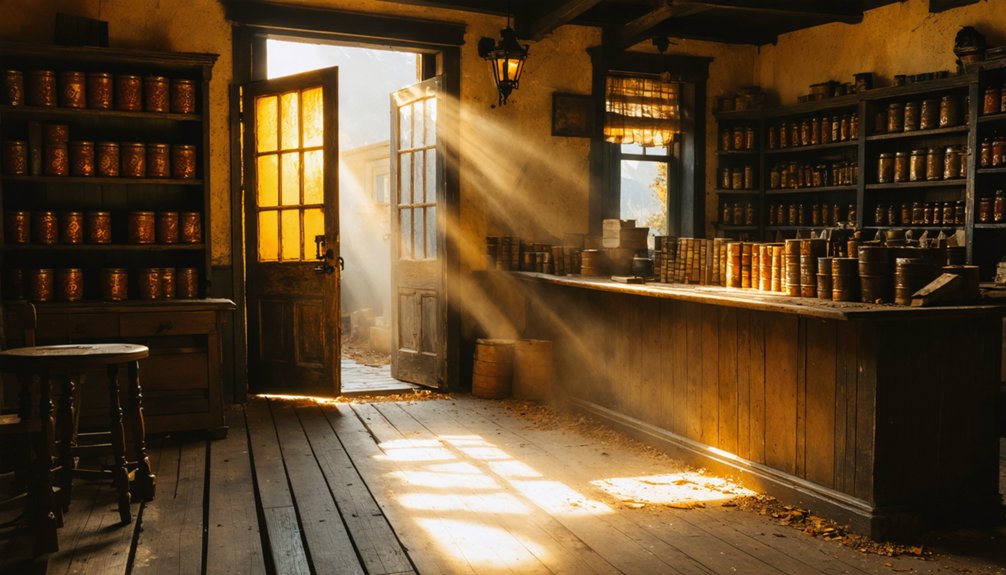
Located at the base of the Sierra Nevada mountains, Genoa stands as Nevada’s oldest settlement, established in 1851 as Mormon Station during the height of westward expansion.
Genoa’s transformation from trading post to living ghost town reflects its rich pioneer heritage, where early settlers like John Reese established vital supply lines for California-bound travelers.
You’ll discover these remarkable features that shaped the town’s destiny:
- The state’s oldest saloon, surviving as a symbol of frontier hospitality
- A restored 1947 replica of the original Mormon Station fort
- The historic Pink House from 1855, once serving as the county seat
- The Genoa Cemetery, final resting place of legendary “Snowshoe” Thompson
Unlike many abandoned mining towns, Genoa thrives as a living museum, preserving its trading post roots while embracing modern tourism through events like the annual Candy Dance festival.
Silver City: Riches to Ruins in the Comstock Lode
Deep in the heart of Nevada’s mining country, Silver City emerged as an essential hub of the Comstock Lode after John Orr and Nicholas Kelly’s gold discovery in June 1850.
You’ll find a town that quickly grew to 1,200 residents by 1861, boasting hotels, saloons, and Nevada Territory’s first stamp mill.
While the Virginia & Truckee Railroad’s arrival in 1869 marked the beginning of Silver City’s decline, the town’s historic preservation efforts have maintained its authentic charm.
Unlike its commercialized neighbor Virginia City, you can explore genuine Victorian storefronts, the Bank of California building, and mining remnants in relative solitude.
Today, with fewer than 200 residents, Silver City offers you a raw, unvarnished glimpse into the Comstock era, drawing thousands of visitors seeking an authentic ghost town experience.
Aurora: The Lost Sister City of Bodie
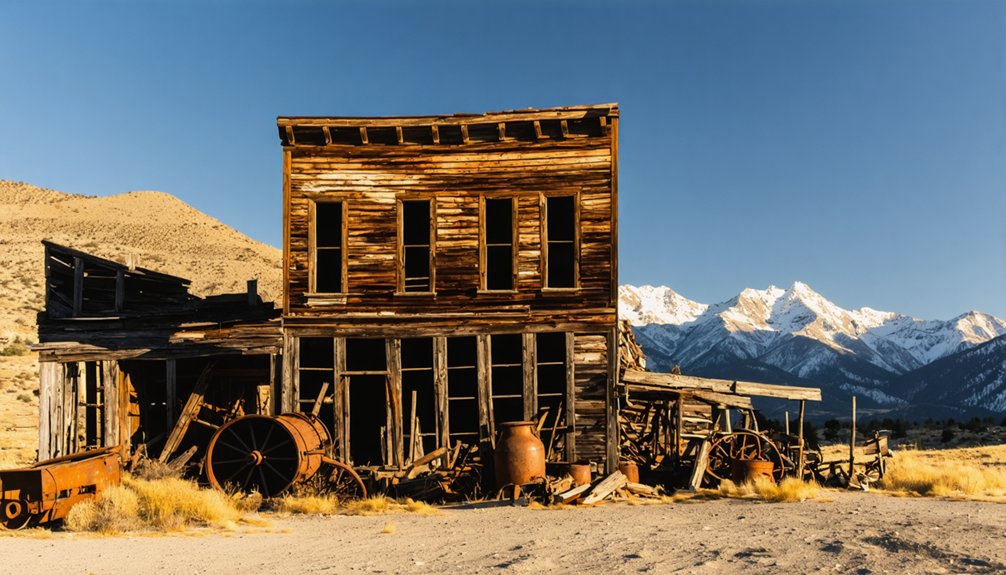
When prospectors discovered the Wild West Vein in 1860, Aurora burst into existence with the explosive force typical of Western gold rushes. At its peak, this boomtown became Nevada’s second-largest city, producing over $27 million in gold and creating a legacy of freedom and lawlessness that defined the American West.
Aurora’s history stands out among Sierra Nevada ghost towns for these unique features:
- Served as the county seat for both California and Nevada due to border confusion
- Hosted Mark Twain during its heyday, though his cabin’s now long gone
- Boasted a largely male population with streets lined by saloons and brothels
- Built distinctive locally-fired brick buildings, all dismantled by the 1960s
Today, you’ll find little more than the cemetery and mill foundations, with a modern mining operation continuing Aurora’s gold-seeking tradition.
Cerro Gordo: Silver Queen of the Inyo Mountains
While Aurora represents the golden dreams of the Sierra Nevada, the silver-rich town of Cerro Gordo emerged as the crown jewel of California’s Inyo Mountains.
You’ll discover a mining heritage that began in 1865 when Mexican prospector Pablo Flores first struck silver in these rugged peaks. At its height, the town produced nearly $500 million in minerals and boasted a thriving community with daily stagecoaches, the American Hotel, and bustling saloons.
From silver strikes to stagecoaches, Cerro Gordo blossomed into a $500 million boomtown after Pablo Flores’s 1865 discovery.
Today, you can explore this privately-owned ghost town‘s 336 acres of vintage buildings and mine ruins, though you’ll need special permission to visit.
While a devastating 2020 fire destroyed several historic structures, including the iconic American Hotel, Cerro Gordo’s new owners are working to preserve this remarkable piece of California’s silver mining history.
Downieville: From Gold Rush Boom to Mountain Town Ghost
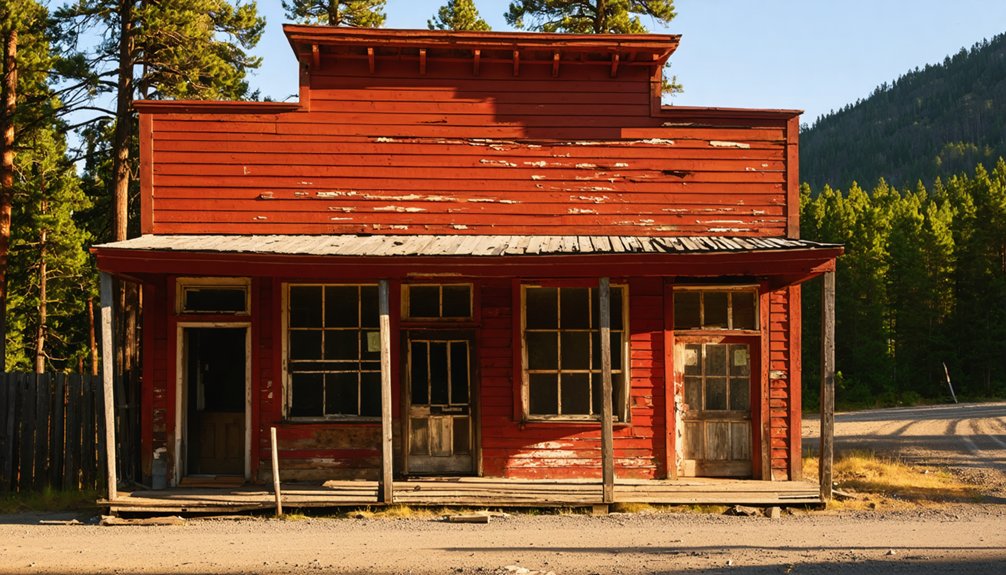
Three pivotal discoveries in 1848-1849 transformed a remote river fork into Downieville, one of California’s most prosperous Gold Rush settlements.
You’ll find this former boomtown nestled at the confluence of the Downie and North Yuba rivers, where early gold rush miners struck it rich using various mining techniques.
During its peak in 1851, Downieville’s population soared to over 5,000 fortune seekers, with claims that would make any prospector envious:
- A 25-pound gold nugget emerged from the river in 1850
- Tin Cup Diggings yielded a tin cup of gold daily
- The Gold Bluff mine launched extensive operations in 1850
- A single 60-foot claim produced $80,000 in six months
Today, with just 325 residents, Downieville stands as a semi-ghost town, though its historic buildings and mining remnants continue drawing adventurous visitors.
Virginia City: The Largest Ghost Town That Never Died
You’ll find Virginia City’s enduring legacy in its remarkably preserved mining-era architecture and bustling tourist trade, defying the typical fate of Western ghost towns.
While the silver that once made it America’s richest boomtown has long since dried up, the town’s 90-plus historic mines and iconic wooden boardwalks continue to draw visitors fascinated by authentic Old West heritage.
Today’s Virginia City thrives as a living museum where you can experience genuine saloons, haunted buildings, and century-old businesses that have seamlessly merged historical preservation with modern tourism.
Mining Legacy Lives On
Despite its classification as a ghost town, Virginia City stands as one of America’s most remarkable examples of living history, where the legacy of the Comstock Lode continues to pulse through its streets.
You’ll find historical preservation at its finest, with over 300 original buildings showcasing authentic 19th-century architecture and mining techniques that helped shape the American West.
- Explore mine shafts reaching 3,000 feet below the streets, where $600 million in precious metals were extracted
- Walk wooden sidewalks past period-style buildings that transport you to the 1850s boom era
- Visit the Mark Twain Museum and former Territorial Enterprise building
- Experience living history through interactive tours and preserved mining equipment
Today’s 800 residents keep the spirit of this National Historic Landmark alive, maintaining its authentic Wild West character while welcoming modern adventurers.
Tourism Drives Modern Growth
While many ghost towns across the American West have crumbled into obscurity, Virginia City has transformed into a thriving tourist destination that welcomes over two million visitors annually.
You’ll find a remarkable blend of historical preservation and modern amenities, with original 19th-century buildings now housing museums, shops, and restaurants along C Street.
The town’s designation as a National Historic Landmark in 1961 sparked intensive restoration efforts, protecting landmarks like the Fourth Ward School and Liberty Engine Company No. 1 firehouse.
Tourism growth has replaced mining as the economic backbone, creating jobs and sustaining the local population of 800-1,000 residents.
Whether you’re exploring haunted hotels, riding the Virginia & Truckee Railroad, or joining ghost walks, you’ll experience a uniquely preserved slice of the Old West.
Frequently Asked Questions
Are Metal Detectors Allowed in Sierra Nevada Ghost Towns?
As you stroll through weathered wooden buildings, you’ll need special permits for metal detecting. Ghost town preservation regulations generally prohibit unauthorized detecting, but you can sometimes obtain permission through proper channels.
What Happens if You Accidentally Take Artifacts From Ghost Town Sites?
You’re still legally liable even if removal was accidental. Return artifacts immediately to site authorities or land managers to minimize legal consequences and support artifact preservation. Ignorance won’t protect you from penalties.
Can You Camp Overnight in Any of These Ghost Towns?
You can’t camp within ghost town boundaries – it’s strictly against camping regulations. However, you’ll find permitted overnight camping on nearby public lands with proper permits and distance requirements.
Do Any Ghost Towns Still Have Active Mining Claims?
You’ll find active mining claims in many ghost towns, particularly in Nevada where companies are exploring for lithium, silver, and gold near historically significant sites like Tonopah and Goldfield.
Which Ghost Towns Are Wheelchair Accessible With Paved Pathways?
Like sentinel outposts of the past, Berlin-Ichthyosaur and Virginia City offer you the best wheelchair accessibility with paved pathways to visitor centers, while most ghost towns have limited paved access.
References
- https://en.wikipedia.org/wiki/List_of_ghost_towns_in_Nevada
- https://en.wikipedia.org/wiki/Wikipedia:WikiProject_Ghost_towns
- https://nvtami.com/top-10-ghost-towns-nevada-northwest/
- https://midlifehealthyliving.com/nevadas-great-basin/
- https://travelnevada.com/ghost-town/
- https://myselectlife.com/2018/09/18/10-ghost-towns-of-california-nevada/
- https://noospheregeologic.com/blog/tag/ghost-towns/
- https://californiahighsierra.com/trips/explore-ghost-towns-of-the-high-sierra/
- https://a-z-animals.com/blog/abandoned-and-forgotten-ghost-towns-in-nevada/
- https://nvtami.com
